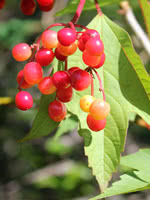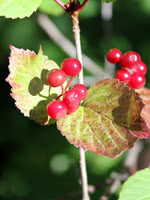Mon-Fri 9am - 5pm Mountain time
Highbush Cranberry vs Lowbush Cranberry
Viburnum opulus var. americanum (trilobum)
Viburnum edule
NOT AVAILABLE THIS SEASON - MIGHT RETURN
Highbush Cranberry produces attractive white flowers in late June and bears edible fruit that matures to a bright red colour in the late summer.
This shrub, native to much of Canada, is fast growing, and its fruit can be eaten raw or cooked into a sauce.
Lowbush Cranberry is a short, deciduous shrub native to North America. Its white flowers bear sour but edible fruit that ripens to a brilliant red in fall. Lowbush Cranberry's small size makes it suitable for urban use; buyers will also find it useful if trying to reclaim land back to its original species or when landscaping with native species in damp conditions.
Highbush Cranberry Quick Facts
Lowbush Cranberry Quick Facts
In row spacing: 0.6 m (2.0 ft)

